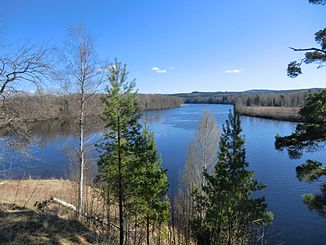Dalälven
|
Dalälven Dal Elf |
||
|
Location of the Dalälven |
||
| Data | ||
| location | Dalarnas län , Västmanlands län , Gävleborgs län , Uppsala län ( Sweden ) | |
| River system | Dalälven | |
| source | from Västerdalälven and Österdalälven 60 ° 33 ′ 0 ″ N , 15 ° 8 ′ 0 ″ E |
|
| Source height | approx. 150 m above sea level | |
| muzzle | near Älvkarleby in the Gulf of Bothnia Coordinates: 60 ° 38 ′ 0 ″ N , 17 ° 27 ′ 0 ″ E 60 ° 38 ′ 0 ″ N , 17 ° 27 ′ 0 ″ E |
|
| Mouth height | 0 m o.h. | |
| Height difference | approx. 150 m | |
| Bottom slope | approx. 0.6 ‰ | |
| length | approx. 250 km (including source rivers 542 km) | |
| Catchment area | 28,953.8 km² | |
| Drain |
MQ |
379 m³ / s |
| Flowing lakes | Färnebofjärden | |
| Medium-sized cities | Bor length | |
| Small towns | Avesta , Hedemora | |
|
Confluence of Österdalälven (left) and Västerdalälven (right) |
||
The Dalälven (formerly also Dal Elf) is a river in the historic Swedish provinces of Dalarna , Västmanland , Gästrikland and Uppland .
geography
The Dalälven is created by the confluence of the Västerdalälven and Österdalälven . On the lower reaches, before the Dalälven flows into the Baltic Sea , there are several lakes, of which the Färnebofjärden forms the center of a national park. At 542 kilometers, the Dalälven river system is the longest in Sweden that flows into the sea . The longest that does not flow into the sea is the Klarälven .
The Dalälven with its headwaters and tributaries drains an area of around 30,000 km². There are numerous factories and pits ( Bergslagen ) that have been in use since the Middle Ages . The Dalälven is therefore the Swedish river that carries the most pollutants into the Baltic Sea (especially heavy metals , cadmium and zinc from mining).
rafting
Rafting on the Dalälven is documented from 1600. An important factor in this was the ban on Charles IX. in 1607, harvesting wood within a Swedish mile of the Falun Mine . Until the great common division ( Storskiftet ) in Sweden-Finland and England's abolition of tariffs on wood products, rafting was only operated on a small scale.
Four important sawmill operators dominated the rafting on the Dalälven: Korsnäs AB, founded in 1858 on the Runn ; the Kopparbergs och Hofors Sågverks Bolag on Hosjön (lake near Falun), which began in 1861 and bought out its competitor Carlfors Sågverksbolag in 1874 ; the Stora Kopparbergs Bergslags AB , their mill on the rapids in 1863 by Domnarvets Jernverk , an iron in Borlänge allowed to modernize; and finally a mill in Älvkarleby , which was replaced by the Skutskär sawmill in 1870 .
Rafting on the Dalälven peaked in 1952 when about 30 million logs were rafted each year. It ended on much of the river in 1970. Even if rafting continued on the lower reaches of the river until 1971, stocks were finally exhausted in 1972. In 1973 the river was finally closed to rafting and in 1977 all rafting facilities were shut down.
Varia
The 29th chapter of Selma Lagerlöf's novel The Wonderful Journey of Little Nils Holgersson with the Wild Geese is dedicated to Daläven .
Web links
Individual evidence
- ↑ Sveriges Meteorologiska och Hydrologiska Institut (SMHI) - Län och huvudavrinningsområden i Sverige (PDF; 2.5 MB)
- ↑ a b c Gösta Hellstrand: Flottningen i Dalälven: utveckling, teknik, organization ( Swedish ). Dalarnas Museum, 1980, pp. 18–33, 44.
- ^ Eva Burman, Henry Eriksson: Dalälven: från havet till källorna ( Swedish ). Rabén & Sjögren , 1987, ISBN 91-29-58214-8 , p. 37.


